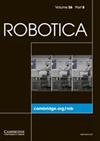Heavy-duty hexapod robot sideline tipping judgment and recovery
IF 2.7
4区 计算机科学
Q3 ROBOTICS
引用次数: 0
Abstract
Heavy-duty hexapod robots are well-suited for physical transportation, disaster relief, and resource exploration. The immense locomotion capabilities conferred by the six appendages of these systems enable traversal over unstructured and challenging terrain. However, tipping can be a serious concern when moving with a tripod gait in these challenging environments, which may cause irreversible consequences such as compromised movement control and potential damage. In this paper, we focus on heavy-duty hexapod robot sideline tipping judgment and recovery during tripod gait motion, and a novel sideline tipping judgment and recovery method is proposed by adjusting an optimal swinging leg to the stance state. Considering the locomotion environments, motion mode, and tipping analysis, the robot’s stability margin is quantified, and the tipping event is evaluated by the Force Angle Stability Measure (FASM). The recovery method is initiated upon detecting that the robot is tipping, which involves the selection of an adjustment leg and the determination of an optimal foothold. Since the FASM is based on the foot force and robot center of gravity (CoG), the stability margin quantification expression is reformulated to the constraint form of quadratic programming (QP). Furthermore, a foot force distribution method, integrating stability margin considerations into the QP model, has been devised to ensure post-adjustment stability of the landing leg. Experiments on tipping judgment and recovery demonstrate the effectiveness of the proposed approaches on tipping judgment and recovery.重型六足机器人边线倾翻判断和恢复
重型六足机器人非常适合实际运输、救灾和资源勘探。这些系统的六个附肢赋予其巨大的运动能力,使其能够穿越无结构和具有挑战性的地形。然而,在这些具有挑战性的环境中以三脚架步态移动时,倾翻可能是一个严重的问题,可能会造成不可逆转的后果,如运动控制能力下降和潜在的损坏。本文重点研究了重型六足机器人在三脚架步态运动过程中的侧线倾翻判断和恢复,并通过调整最佳摆动腿到姿态状态,提出了一种新颖的侧线倾翻判断和恢复方法。考虑到运动环境、运动模式和倾倒分析,量化了机器人的稳定裕度,并通过力角稳定性测量(FASM)评估了倾倒事件。一旦检测到机器人正在倾倒,就会启动恢复方法,包括选择调整腿和确定最佳支点。由于 FASM 基于脚力和机器人重心(CoG),因此稳定裕度量化表达式被重新表述为二次编程(QP)的约束形式。此外,还设计了一种脚力分配方法,将稳定裕度因素纳入 QP 模型,以确保着地腿调整后的稳定性。倾覆判断和恢复实验证明了所提方法在倾覆判断和恢复方面的有效性。
本文章由计算机程序翻译,如有差异,请以英文原文为准。
求助全文
约1分钟内获得全文
求助全文
来源期刊

Robotica
工程技术-机器人学
CiteScore
4.50
自引率
22.20%
发文量
181
审稿时长
9.9 months
期刊介绍:
Robotica is a forum for the multidisciplinary subject of robotics and encourages developments, applications and research in this important field of automation and robotics with regard to industry, health, education and economic and social aspects of relevance. Coverage includes activities in hostile environments, applications in the service and manufacturing industries, biological robotics, dynamics and kinematics involved in robot design and uses, on-line robots, robot task planning, rehabilitation robotics, sensory perception, software in the widest sense, particularly in respect of programming languages and links with CAD/CAM systems, telerobotics and various other areas. In addition, interest is focused on various Artificial Intelligence topics of theoretical and practical interest.
 求助内容:
求助内容: 应助结果提醒方式:
应助结果提醒方式:


